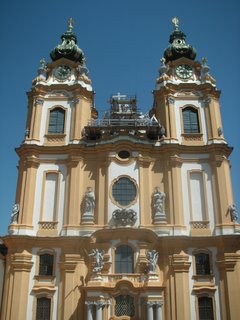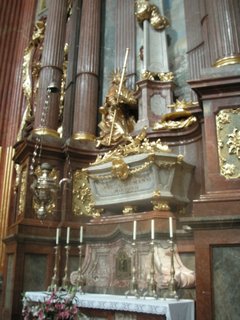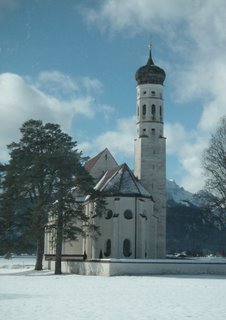The Irish Saint of Melk


One of Austria’s top tourist destinations is the Benedictine Abbey of Melk (above). Most people go, of course, because of its spectacular position, perched over the River Danube, and its baroque architecture, built very much on the grand scale. When I made the journey there last Tuesday, I’m pretty sure that I was one of the few people on the train who was also intending to pay my respects to an Irishman, St Coloman (or Colman), whose relics are enshrined in the beautiful church.

Rather amazingly this obscure Celt was the patron saint of Austria before his contemporary, St Leopold, replaced him in 1663. We know nothing about Coloman’s early life, except that he came from Ireland (or possibly Scotland). Later tradition identifies him as a King's son and he is often shown in pilgrim's garb, with a crown at his feet.
Around 1012 the saint embarked on a pilgrimage to Jerusalem, as many did at the time despite the perils of travel and the unstable situation in the Middle East. Unfortunately, the region around Vienna was also volatile, with ongoing conflict between the Austrians, Bohemians and Moravians. St Coloman, with his strange language and clothing, was captured at Stockerau on suspicion of being a spy. Unable to defend himself owing to the barrier of language, he was hanged from a tree on 13th July 1012.
Perhaps the people of Stockerau found out his real identity and began to feel guilty for a cult of ‘Coloman the Martyr’ soon emerged and miracles were claimed. When, on 13th October 1014, his body was moved to Melk, it was found to be incorrupt. His remains still rest there, now ornamented by a Baroque altarpiece, with the saint kneeling at the foot of a rather striking obelisk ascending towards Heaven.

Many churches are dedicated to him in German speaking lands, including this famous pilgrimage church (Wallsfahrtskirche St Coloman) in Schwangau, Bavaria, not far from Mad King Ludwig's Schloss Neuschwanstein. It is believed that St Coloman passed through the area on his way to the Holy Land and that he rested, preached and/or even pastured cattle here. This perhaps explains the colourful celebrations on the Sunday nearest to his feast (13th October), the Colomansfest. The little church is surrounded by several hundred horses and decorated carriages. After Mass, the devotees of the Irish pilgrim ride around the church three times to receive his blessing - followed by a feast of beer and meat. Here's a picture I took of the church through a coach window back in February.

The Melk website draws out the contemporary relevance of the saint: 'in our times, where listening to each other has become increasingly difficult, he can be seen as a contemporary saint, as he, stranger in a strange land, was not understood. Whoever is different, looks or speaks differently, makes himself suspicious, causes fear, and can easily become the victim of prejudice.'
Labels: Saints



0 Comments:
Post a Comment
<< Home